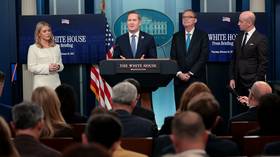Indian factory activity bounces back on surging domestic & foreign demand
India’s manufacturing sector rebounded in July, allowing local business to offer new jobs for the first time since the coronavirus pandemic outbreak. The expansion was underpinned by robust demand domestically and abroad.
The Manufacturing Purchasing Managers’ Index for the sector jumped to 55.3 in July from 48.1 recorded in the previous month, according to survey data revealed by IHS Markit on Monday. The July reading is well above the 50-level that separates growth from contraction.
“Output rose at a robust pace, with over one-third of companies noting a monthly expansion in production, amid a rebound in new business and the easing of some local Covid-19 restrictions,” said Pollyanna De Lima, economics associate director at IHS Markit.
Indian authorities have eased most of the Covid-related restrictions as the number of cases entered a downward trajectory after the nation was hit by a devastating second wave of the pandemic in April and May.
Also on rt.com Economic activity picks up across India as mobility levels riseReopening of the nation’s economy spurred higher demand and sales, leading to a sharp expansion of output, though New Delhi is still reporting over 40,000 cases a day, with the total number of infections reaching nearly 31.6 million.
New export orders reportedly increased at the fastest rate since April, while employment grew for the first time since March 2020. However, the pace of hiring in July was slow, showing that the job crisis is not over yet.
In spite of higher input costs, output charges rose only slightly, suggesting companies absorbed the extra cost burden to boost sales and stay competitive.
“With firms’ cost burdens continuing to rise, however, and signs of spare capacity still evident, it’s too early to say that such a trend will be sustained in coming months,” De Lima said.
For more stories on economy & finance visit RT's business section














